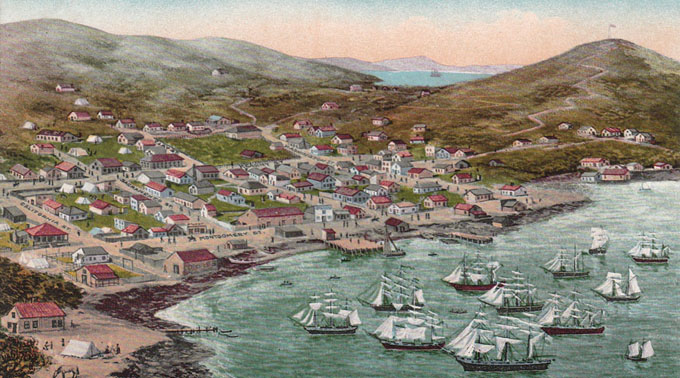Sea Captains: San Francisco 1800s
George T. Estabrooks
Scene Below Decks.

In 1849, Captain Estabrooks took over command of the SS Pacific in Rio de Janeiro from Captain Hall J. Tibbetts, who had been receiving complaints from passengers. Captain Tibbetts had sailed the ship from New York to Rio with the intention of bringing her to San Francisco. However, because of the complaints, Captain Estabrooks took charge and brought her from Rio to San Francisco, arriving on August 5, 1849.
Among the passengers on that ship leaving New York on January 22, 1849 was Mark Hopkins. One account relates that this Mark Hopkins formed the New England Mining Company, comprised of 26 men, each of whom invested $500 in the venture. With a capital of $13,000, they bought a large supply of mining equipment, which they intended to sell in California arriving in San Francisco on August 5, 1849.
A card from this group was printed in the San Francisco's Alta California newspaper on August 23, 1849:
San Francisco, August 10, 1849
To Captain George T. Estabrooks:Dear Sir--The undersigned passengers recently arrived on board the ship Pacific from New York, beg leave to use this method of expressing to you some small degree of the gratitude we owe you for the kindness shown us, on all occasions, during your command of that ship from Rio Janeiro to this port. We assure you we shall ever carry with us a pleasing recollection of a voyage that, though often attended by trials and dangers, has been a source of so much pleasure to us through your humanity and unsurpassed seamanship.
Ezra A. Hopkins, Michigan;
E.H. Miller, Jr., W.K. Sherwood, New York;
Mark Hopkins

View of Golden Gate and Fort Point San Francisco, California
The Presidio has served as a military reservation from its establishment in 1776 as Spain's northern-most outpost of colonial power in the New World. It was one of the longest-garrisoned posts in the country and the oldest installation in the American West. In 1846, during the Mexican-American War, the 7th New York Volunteer Infantry Regiment occupied the crumbling adobes at the Presidio. The U.S. Regular Army took over the post the following year. This military reservation at the Golden Gate developed into the most important Army post on the Pacific Coast. Over time its armaments evolved from smooth bore cannons to modern missiles. It became the nerve center of a coastal defense system that eventually included Alcatraz and Angel Island and that reached as far north as the Marin Headlands and as far south as Fort Funston. Eventually, there were five distinct posts at the Presidio, each with its own commander: the Main Post, Fort Point, Letterman Hospital, Fort Winfield Scott, and Crissy Army Air Field. Also on the 1,491-acre reservation were a Coast Guard lifesaving station and a U.S. Public Health Service Hospital. From 1847 to about 1890, the Presidio defended San Francisco and also participated in the Indian Wars in the West. From the Spanish-American War of 1898 and the conquest of the Philippines to the end of the Vietnam War in 1973, the Presidio was a key link in the projection of American military power into the Pacific Basin and further west onto the mainland of Asia. New concrete fortifications built after the 1890s indirectly preserved native plant communities on the dramatic Pacific bluffs by making them off-limits.
The Authority to Sail: The History of U.S. Maritime Licenses and Seamen's Papers
Robert Stanley Bates, George Marsh (Editor), John F. Whiteley (Forward) (Batek Marine Publishing, 2011; Nominated in 2012 for a Pulitzer Prize)
This book depicts important aspects of our maritime history as a result of original research done by the author, Commodore Bates, the holder of an unlimited master's license who has enjoyed a distinguished fifty-year career in both the Coast Guard and the American Merchant Marine.
The U.S. Coast Guard issues all Captain Licenses for U.S. Ports.
Note: Other countries have different regulations, i.e. the RYA (Royal Yachting Association), conducts certification for Britain and Ireland. As of 2011, they did not recognize the USCG certification; certification through their courses was required.Master Unlimited is a licensed mariner in ultimate command of a vessel any gross tons. The captain is responsible for its safe and efficient operation, including cargo operations, navigation, crew management and ensuring that the vessel complies with local and international laws. All persons on board, including officers and crew, other shipboard staff members, passengers, guests and pilots, are under the captain's authority and are his or her ultimate responsibility. The STCW defines the Master as Person having command of the ship.
The Sea Chart
The Illustrated History of Nautical Maps and Navigational Charts
John Blake
The sea chart was one of the key tools by which ships of trade, transport and conquest navigated their course across the oceans. Herein is a history and development of the chart and the related nautical map, in both scientific and aesthetic terms, as a means of safe and accurate seaborne navigation. 150 color illustrations including the earliest charts of the Mediterranean made by 13th-century Italian merchant adventurers, as well as 18th-century charts that became strategic naval and commercial requirements and led to Cook's voyages in the Pacific, the search for the Northwest Passage, and races to the Arctic and Antarctic.
Get Your Captain's License. Fifth Edition
Charlie Wing
Considered the quickest, easiest, and least expensive way to prepare for the U.S. Coast Guard captain's ratings exams required for anyone who takes paying passengers on a boat, and useful for serious boaters who want to save money on insurance. 350 pages of seamanship and navigation tutorials. More than 1,500 questions and answers from the Coast Guard exams. Includes an interactive CD-ROM with all 14,000 questions and answers in the USCG database, so you can take an unlimited number of practice exams








 Copyright ~ 1998-2018.
Copyright ~ 1998-2018. 